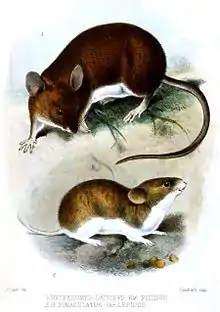| Euryoryzomys | |
|---|---|
 | |
| Euryoryzomys nitidus (top) and Calomys laucha (bottom) | |
| Scientific classification | |
| Domain: | Eukaryota |
| Kingdom: | Animalia |
| Phylum: | Chordata |
| Class: | Mammalia |
| Order: | Rodentia |
| Family: | Cricetidae |
| Subfamily: | Sigmodontinae |
| Tribe: | Oryzomyini |
| Genus: | Euryoryzomys Weksler et al., 2006 |
| Type species | |
| Oryzomys macconnelli Thomas, 1910 | |
Euryoryzomys is a genus of rodents in the tribe Oryzomyini of family Cricetidae.[1] It includes seven species, which are distributed in South America.[1][2] Until 2006, its members were included in the genus Oryzomys, but they are not closely related to the type species of that genus, and therefore they were placed in a new genus.[1] They are most closely related to genera like Hylaeamys and Transandinomys; many members of these genera were previously placed in a single species, known as Oryzomys capito.[1] The genus name, Euryoryzomys, combines the name "Oryzomys" with the Ancient Greek word eurus "broad", referring to the broad range in distribution of the genus.[1]
It includes the following species:
- Euryoryzomys emmonsae (Musser, Carleton, Brothers & Gardner, 1998)
- Euryoryzomys lamia (Thomas, 1901)
- Euryoryzomys legatus (Thomas, 1925)
- Euryoryzomys macconnelli (Thomas, 1910)
- Euryoryzomys nitidus (Thomas, 1884)
- Euryoryzomys russatus (Wagner, 1848)
- Euryoryzomys cerqueirai Percequillo & Weksler, 2023[2]: 607
References
- 1 2 3 4 5 Weksler, M.; Percequillo, A. R.; Voss, R. S. (2006-10-19). "Ten new genera of oryzomyine rodents (Cricetidae: Sigmodontinae)". American Museum Novitates. American Museum of Natural History (3537): 1–29. doi:10.1206/0003-0082(2006)3537[1:TNGOOR]2.0.CO;2. hdl:2246/5815.
- 1 2 Percequillo, A. R.; Weksler, M. (2023). "Systematics of the genus Euryoryzomys Weksler et al., 2006 (Rodentia: Cricetidae): integrative analysis reveals a new species from north-eastern Brazil". Zoological Journal of the Linnean Society. 199 (3): 594–632. doi:10.1093/zoolinnean/zlad048.
This article is issued from Wikipedia. The text is licensed under Creative Commons - Attribution - Sharealike. Additional terms may apply for the media files.